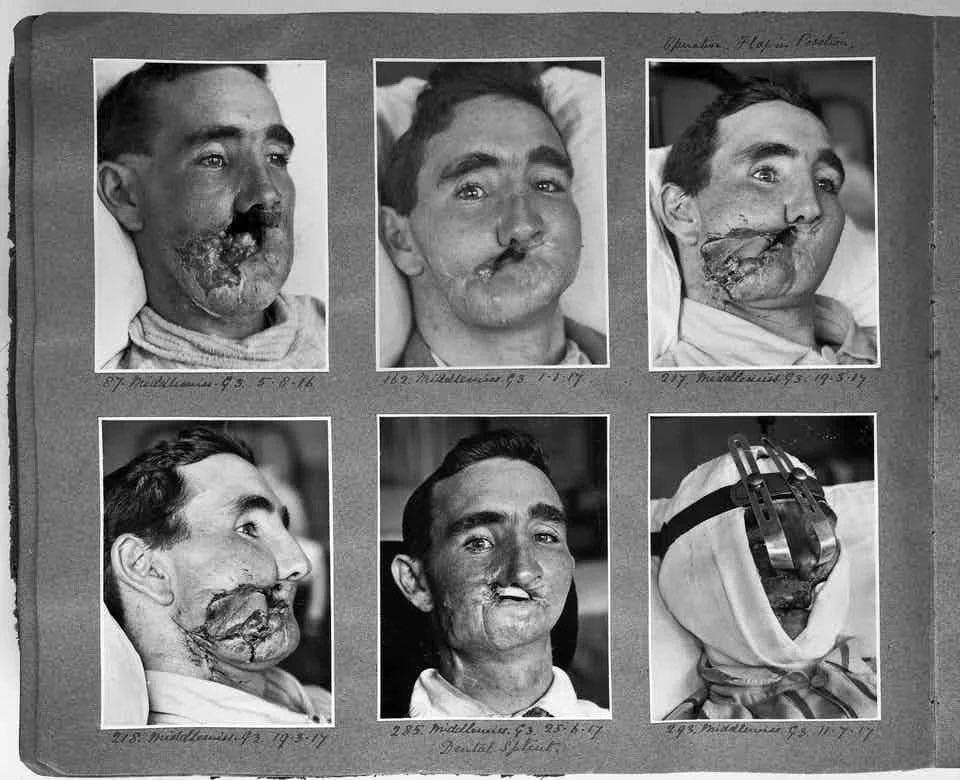
On #ArmisticeDay we also recognise and honour the service of military surgeons, whose dedication pioneered major advancements in #medicine, and improved outcomes for veterans.
A thread about #PlasticSurgery and its origins on the battlefield
🪡🧵
A thread about #PlasticSurgery and its origins on the battlefield
🪡🧵

Never before #WWI had conflict brought such mass devastation in terms of death and injury: 37M military and civilian casualties. 16M dead and 21M wounded.
Image: the Western Front during WWI, generations of trenches & thousands of craters from mortars, artillery & detonations.
Image: the Western Front during WWI, generations of trenches & thousands of craters from mortars, artillery & detonations.

During 4 years of #WWI, military surgeons developed new techniques on the battlefield and in supporting hospitals.
In the war’s final 2 years, their work resulted in more survivors of injuries that would have previously proved mortal.
In the war’s final 2 years, their work resulted in more survivors of injuries that would have previously proved mortal.

The majority of injuries were caused by shell blasts and shrapnel, and many severely affected the face.
Historically, little had been attempted to treat survivors left with major facial deformities that substantially impaired their vision, breathing, or the ability to eat/drink.
Historically, little had been attempted to treat survivors left with major facial deformities that substantially impaired their vision, breathing, or the ability to eat/drink.

Harold Gillies, an ENT surgeon from NZ working on the Western Front recognised the need for specialised work to repair the ravages of facial injuries.
On returning to England, Gillies set up a ward for facial wounds at the Military Hospital in Aldershot.
Image via @QMHistory
On returning to England, Gillies set up a ward for facial wounds at the Military Hospital in Aldershot.
Image via @QMHistory

At this time, military medical leadership were recognising the benefit of treatment centres for specific injuries & wounds (eg. neurosurgical, orthopaedics)
By 1916, Gillies had convinced medical chiefs of the need for a dedicated hospital for the treatment of facial injuries.
By 1916, Gillies had convinced medical chiefs of the need for a dedicated hospital for the treatment of facial injuries.

After touring base hospitals in France to seek out suitable patients, Gillies returned, expecting ~200 individuals – but the opening of the unit coincided with the start of the #Somme offensive in 1916, resulting in over 2,000 patients with facial injuries sent to #Aldershot. 

Among the first patients to be treated was Walter Yeo, gunnery warrant officer on the HMS Warspite, who’d sustained facial injuries during the Battle of Jutland in 1916 - including the loss of his upper and lower eyelids. 

Yeo was among the first to be treated with a newly developed #ReconstructiveSurgery technique called a tube pedicle that produced a “mask” of skin grafted across his face and eyes, producing new eyelids.
Thanks to Gillies’ innovative surgical interventions, Yeo lived to be 70.
Thanks to Gillies’ innovative surgical interventions, Yeo lived to be 70.

Gillies went on to perform similar #ReconstructiveSurgery procedures on thousands of other wounded patients.
Image: Facsimile of a wax teaching model demonstrating facial reconstruction methods, c1917 courtesy @NAM_London
collection.nam.ac.uk/detail.php?acc…
Image: Facsimile of a wax teaching model demonstrating facial reconstruction methods, c1917 courtesy @NAM_London
collection.nam.ac.uk/detail.php?acc…

Vast numbers of wounded highlighted a need for larger facilities for surgical & post-op treatment as well as rehab & space to accommodate the different specialities involved in pt care.
Gillies played a key role in designing a specialist unit at Queen Mary’s Hospital in Sidcup.
Gillies played a key role in designing a specialist unit at Queen Mary’s Hospital in Sidcup.

Queen Mary’s Hospital, Sidcup, opened in 1917, with wards, operating theatres, X-ray and pathology departments, and featured a dental workshop and rehabilitation facilities on the grounds.
Remarkably, the effort was funded almost exclusively by private donations.
Remarkably, the effort was funded almost exclusively by private donations.

Patients at Sidcup had access to many specialised services to support their recovery - from occupational therapies and business studies to enjoying the benefits of sport.
Here, we see the members of the 1921/22 Sidcup patients’ football team.
Here, we see the members of the 1921/22 Sidcup patients’ football team.

In 2018, to commemorate the #ArmisticeDay centenary, @RCSnews & @BAPRASvoice presented a collection of images and artefacts documenting the history of #PlasticSurgery
Read more about the incredible work of pioneering surgeons like Gillies & his team: bapras.org.uk/media-governme…
Read more about the incredible work of pioneering surgeons like Gillies & his team: bapras.org.uk/media-governme…

Sir Harold Delf Gillies was knighted in 1930, and he is widely regarded as the father of #PlasticSurgery.
For a deeper dive into this fascinating surgeon’s history, we recommend reading Gillies Archivist Dr Andrew Bamji FRCP’s profile, via @BAPRASvoice
bapras.org.uk/media-governme…
For a deeper dive into this fascinating surgeon’s history, we recommend reading Gillies Archivist Dr Andrew Bamji FRCP’s profile, via @BAPRASvoice
bapras.org.uk/media-governme…

We hope you enjoyed this thread - read more about the development of facial surgery from Dr Bamji via @PMFAJournal ➡️ thepmfajournal.com/features/post/…
We close with a 1917 Christmas postcard of the Queen’s Hospital, Sidcup - a fascinating artefact from #PlasticSurgery history.
/END
We close with a 1917 Christmas postcard of the Queen’s Hospital, Sidcup - a fascinating artefact from #PlasticSurgery history.
/END

@threadreaderapp unroll
• • •
Missing some Tweet in this thread? You can try to
force a refresh



